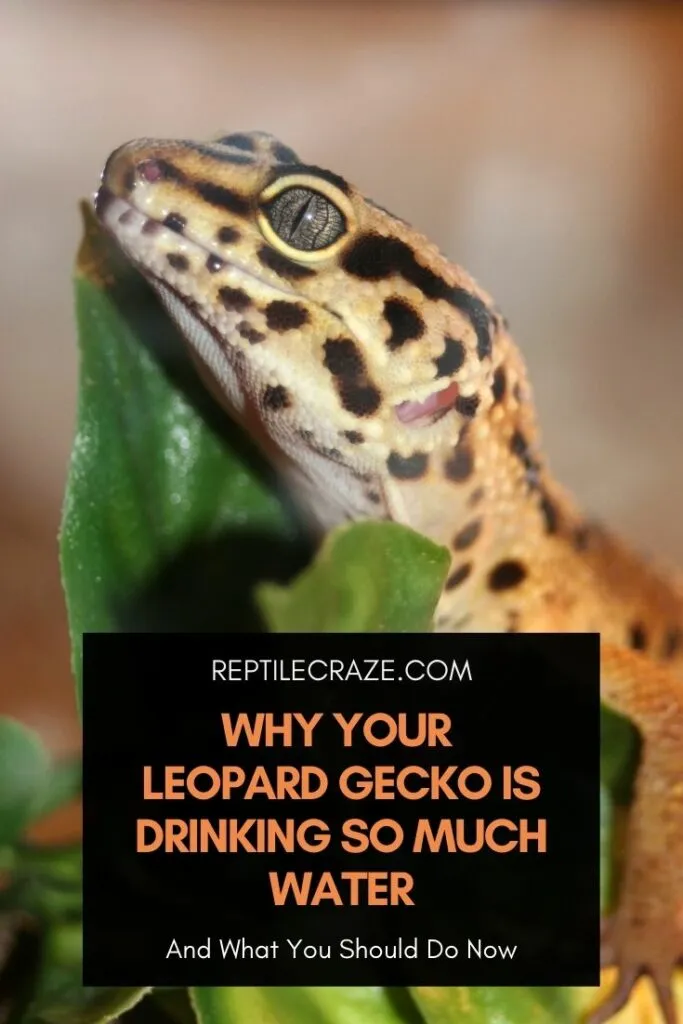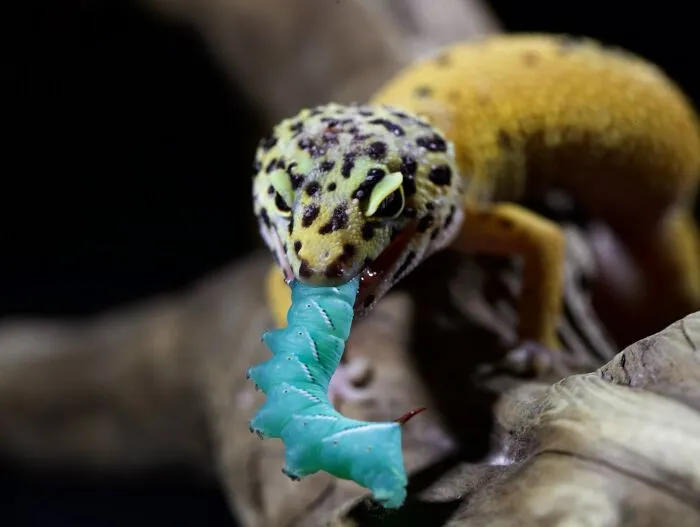
Last year, I noticed that my Leopard gecko, Ralf, was drinking a lot more water than usual. Soon, other symptoms followed and I realized that he was very ill. With some research, I solved all of his issues, but I wish I had known that his excess water intake was the first sign of trouble.
If your leopard gecko is drinking a lot more water than usual, it is a sure sign of dehydration. The most common reasons for dehydration in leopard geckos are incorrect
In this article, I want to help you to understand why your leopard gecko is dehydrated and what you can do about it so that you can avoid the problems I faced with Ralf.
Table of Contents
How to Know Your Leopard Gecko is Drinking Too Much
First, you will want to be able to identify if your leopard gecko is drinking too much, and I am not talking about him going to a bar and downing six tequila shooters. Leopard geckos are mean drunks.
Leopard geckos live in dry grassland, rocky or desert climates. They have perfected being able to go a long time without drinking by absorbing moisture from their
However, they should still drink water every couple of days.
Because these lizards rarely drink, even experienced gecko owners do not often see them sipping from their pool. They also tend to drink at night (not at a bar) while no one is around. This makes seeing a leopard gecko drinking an unusual sight for owners.
If your leopard gecko is drinking from its pool more than once a day, then it is definitely dehydrated.
Your gecko might have headed over to its pool, but you cannot be certain whether it took a sip or not. Here is a helpful video showing you what a leopard gecko drinking looks like.
If you see your gecko drinking too often, what should you do?
Other Signs of Dehydration in Leopard Geckos
As I said at the beginning, my pet gecko, Ralf, had other issues that followed his excessive water drinking. You should look out for these as they will help you know two things:
- How badly dehydrated your pet is
- What you need to do to improve hydration
So, what sort of things should you look out for? Here is a comprehensive list of dehydration symptoms in leopard geckos:
- Weakness
- Stumbling
- Lethargy
- Difficulty supporting weight
- Dried up skin
- Loose or elasticated skin
- Dry deposits around eyes and nose
- Dry looking tongue
- Change in behavior such as becoming timider
- Suddenly not responding to usual
food cues - Refusing to eat
- Constipation and/or fewer bowel movements
- Weight loss
- Problems shedding skin
- Sunken eyes
- Coma
- Muscle twitching
- Cardiac arrhythmia
How to Test for Dehydration
If you are unsure whether your gecko is dehydrated or not, there is a quick method to assess this yourself. Take your thumb and your forefinger and very gently pinch a small amount of your gecko’s skin between them.
- If skin settles easily – no or mild dehydration.
- If skin bunches up and does not settle – moderate to severe dehydration.
Make sure you are very gentle doing this as you do not want to injure the animal, especially if it is already in a weakened state.
Dangers of Dehydration in Leopard Geckos
As any lizard or reptile owner will tell you, as soon as you see a problem with your pet, you have to act fast. Reptiles are notorious for having slower metabolisms than mammals, and so when symptoms arise the underlying issue has probably been there for a while.
If left untreated, dehydration can cause death in a leopard gecko. I hate to put it too bluntly, but I almost lost little Ralf due to this issue, and so it is important that you understand the gravity of the situation.
Dehydration causes:
Acidosis: This occurs when either the acidity of the gecko’s blood increases or the alkaline levels decrease. When the acidity of the body is out of balance, organ failure soon follows.
Uremia: When the body no longer functions well enough to remove toxins and waste products from its system, blood, nitrate, and amino acids are found in the animal’s urine. If this goes on long enough, the animal suffers kidney failure.

Why Your Leopard Gecko is Dehydrated
Let’s not be all doom and gloom. You can help your little gecko recover in most cases, but you need to know the primary causes of the dehydration before you can fix it.
There are three main reasons for your gecko getting dehydrated: Water, Food, and Environment.
Water and Dehydration
Water problems can include:
- Not enough water being made available
- Dirty water that puts your gecko off from drinking
- Poor quality water from a tap. If your local water quality is poor or heavily sterilised with chemicals, this can disagree with your gecko.
Food and Dehydration
Geckos have evolved to absorb a good portion of their water requirements from their
Dehydration from
- Overly dried
food - Rotting or out of date
food - Not providing enough
food regularly. Adult geckos should eat every two days, juveniles every day. - Not varying the
food on offer enough. Leopard geckos love crickets, locusts, mealworms and waxworms. - Not meeting your gecko’s dietary requirements. This can happen if you offer foods that are not good or suitable for your gecko.
Environment and Dehydration
Like most lizards, geckos have evolved to live and function in very specific climates. If you do not create the correct environment for your leopard gecko, it could easily not get the water it needs.
Concerns here include:
- Low humidity. The air in the
tank should have a good level of humidity (water moisture in the air). - Providing inadequate amounts of bathing water. Although leopard geckos rarely bathe, they do need to from time to time to stay hydrated.
- Using substrates that absorb humidity too much such as sponge or powdered materials.
- Substrates that can be too easily eaten are also problematic as they can cause impaction of the bowels, stopping the gecko from drinking and eating.
- Having too high a temperature for long stretches of time. While lizards require light and heat to increase their body temperature, too much can cause them to dry out.
- No adequate shade. Leopard geckos enjoy bathing under the heat, but they also need to shade and hide to function and feel safe.
How to Treat a Dehydrated Leopard Gecko
How you treat your leopard gecko for dehydration is going to depend on the cause, its general health, and how severe the dehydration is.
If your gecko is extremely ill or unresponsive, take your pet to a vet.
A vet will be able to treat acute dehydration quickly through intravenous injections of fluids and other treatments to boost their metabolism.
If your gecko is simply showing signs of mild to moderate dehydration, such as dry skin that does not pull back after being pinched, then you can intervene.
Try the following:
Assess the Causes
Go through the above-listed causes, looking at
Bathe Your Gecko
If your gecko is refusing to dip into the bathing water you have provided, make sure it is clean and chemical-free, and then gently lift your gecko into the water twice a day, letting it soak there for several minutes at a time.
Geckos should only be bathed like this to cure dehydration or solve skin issues, as there are good reasons to not bathe leopard geckos otherwise.
Make sure you keep the water level low enough so your pet cannot drown.
Offer Fresh Nutritious Food
Live

Water Changes
Keep drinking and bathing water clean. Change it every day.
Water Purity
Bottled, rain, filtered or distilled water is ideal. Tap water is okay if unavoidable. You can also treat tap water with a water conditioner to remove chlorine and other chemicals.
Give Water
In more extreme situations, you may have to purchase a small plastic syringe and spray water into your gecko’s mouth with it. A vet can help with this if you are unsure.
Mist Regularly
Geckos absorb water from the air. Spray water mist into your
Maintain Correct Temperature
For a leopard Gecko, the basking spot should be between 35 and 40 degrees Celsius (95F to 104F), with the cool zone of the
Usually, the rest will fall into place. At night, make sure your heat lamp is turned off, but do not let your
UVB Lamp
For general health, your gecko needs a UVB lamp with a rating of about 5-6% output. Too powerful a UVB lamp will cause dehydration and potentially death. 5-6% will allow your gecko to absorb vitamin D, promoting general health that will encourage drinking and eating.
Fix this lamp as high up as possible and at one end of the
Conclusion
I hope all of this has helped you see why your leopard gecko is drinking so much water. Hopefully, this article helps cure your leopard gecko’s dehydration problem.
When in doubt, visit a vet. My gecko, Ralf, is doing great after following these tips. Hopefully having all of the information in one place has allowed you to get your pet back on his or her feet, too.
- Enchi Ball Python: A Unique and Stunning Morph of Python regius - March 27, 2025
- Emerald Tree Monitor: The Enigmatic Green Guardian of the Rainforest - March 26, 2025
- The Egyptian Cobra (Naja haje): A Fascinating Serpent - March 25, 2025
